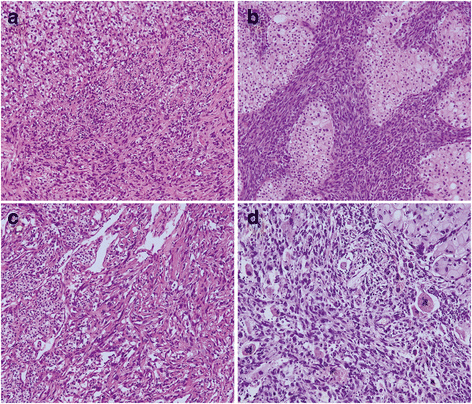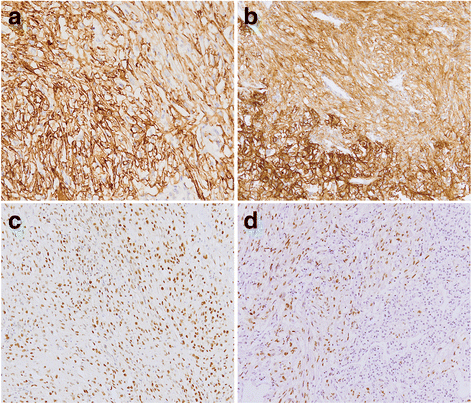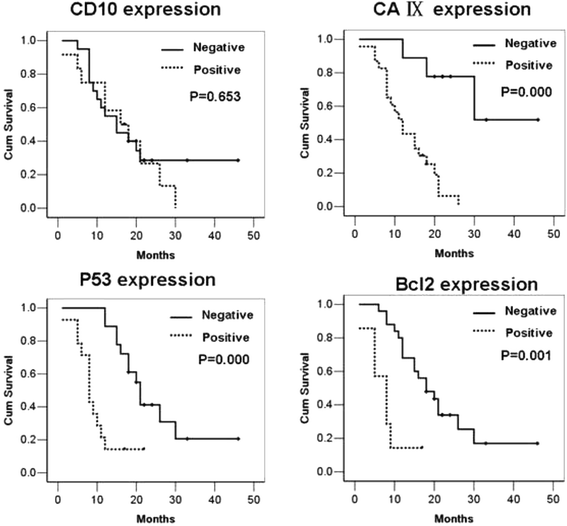Distinct immunophenotypes and prognostic factors in renal cell carcinoma with sarcomatoid differentiation: a systematic study of 19 immunohistochemical markers in 42 cases
- PMID: 28449664
- PMCID: PMC5408832
- DOI: 10.1186/s12885-017-3275-8
Distinct immunophenotypes and prognostic factors in renal cell carcinoma with sarcomatoid differentiation: a systematic study of 19 immunohistochemical markers in 42 cases
Abstract
Background: Renal cell carcinoma (RCC) with sarcomatoid differentiation is a relatively rare tumor containing both carcinoma and sarcomatoid components. However, there has not been a systemic study on immunophenotypes of renal cell carcinoma with sarcomatoid differentiation, especially using some renal specific immunohistochemical markers. In this study, we aimed to comprehensively investigate the distinct immunophenotypes of RCC with sarcomatoid differentiation to analyze the pathogenesis of sarcomatoid differentiation and identify new prognostic factors in RCC with sarcomatoid differentiation.
Methods: A total of 42 cases of RCCs with sarcomatoid differentiation were enrolled into the study. Immunohistochemistry study was performed on tissue microarrays to evaluate the expressions of 19 immunohistochemical markers including a series of epithelial, mesenchymal markers and RCC specific markers. Kaplan-Meier method was applied to assess the prognostic values of CD10, CAIX, p53 and Bcl-2.
Results: Histologically, 42 cases of RCCs with sarcomatoid differentiation presented with different proportions of carcinoma and sarcomatoid components. The cohort contained 35 cases of clear cell renal cell carcinoma (CCRCC) and 7 cases of chromophobe renal cell carcinoma (ChRCC) based on the carcinoma components. Immunohistochemically, all cases were positive for vimentin, and 80% of cases showed immunostaining for at least one epithelial marker, such as CK, EMA, CK7 and CK18. Notably, the expression rates of CAIX, CD10 and PAX8 in sarcomatoid cells were 76%, 76% and 64%, respectively. The carcinoma component of the tumors showed differentient labeling for CAIX, CD10, vimentin, CK7 and CD117 in CCRCC vs ChRCC, but the sarcomatoid component lost the specificity for these markers ( p < 0.05). Patients with positive expressions of CAIX, p53 and Bcl-2 had a poor prognosis.
Conclusions: The sarcomatoid cells in RCC with sarcomatoid differentiation express both epithelial and mesenchymal markers, supporting their epithelial origin. PAX8, CAIX and CD10 could be used as the reliable and useful markers to determine the renal origin of sarcomatoid cells such as in fine needle aspiration cases and metastatic RCC with sarcomatoid differentiation. CAIX, p53 and Bcl-2 might play important roles in the transformation from renal cell carcinoma to high malignant sarcomatoid differentiation, and these three immunohistochemical markers are adverse prognostic factors for the survival of patients with RCC with sarcomatoid differentiation.
Keywords: Immunohistochemistry; Pathogenesis; Renal cell carcinoma; Sarcomatoid.
Figures



Similar articles
-
[Clinicopathological features and prognosis of renal cell carcinoma with sarcomatoid differentiation].Zhonghua Zhong Liu Za Zhi. 2015 Nov;37(11):823-6. Zhonghua Zhong Liu Za Zhi. 2015. PMID: 26887511 Chinese.
-
Adult renal cell carcinoma with rhabdoid differentiation: incidence and clinicopathologic features in Chinese patients.Ann Diagn Pathol. 2015 Apr;19(2):57-63. doi: 10.1016/j.anndiagpath.2015.01.006. Epub 2015 Feb 2. Ann Diagn Pathol. 2015. PMID: 25708024
-
Chromophobe renal cell carcinoma (RCC): oncological outcomes and prognostic factors in a large multicentre series.BJU Int. 2012 Jul;110(1):76-83. doi: 10.1111/j.1464-410X.2011.10690.x. Epub 2011 Nov 1. BJU Int. 2012. PMID: 22044519
-
Immunohistochemical diagnosis of renal neoplasms.Arch Pathol Lab Med. 2011 Jan;135(1):92-109. doi: 10.5858/2010-0478-RAR.1. Arch Pathol Lab Med. 2011. PMID: 21204715 Review.
-
Review of sarcomatoid renal cell carcinoma with focus on clinical and pathobiological aspects.Histol Histopathol. 2003 Apr;18(2):551-5. doi: 10.14670/HH-18.551. Histol Histopathol. 2003. PMID: 12647806 Review.
Cited by
-
Epidemiology, biology and treatment of sarcomatoid RCC: current state of the art.World J Urol. 2019 Jan;37(1):115-123. doi: 10.1007/s00345-018-2355-y. Epub 2018 Jun 1. World J Urol. 2019. PMID: 29858701 Review.
-
Validation of a hypoxia related gene signature in multiple soft tissue sarcoma cohorts.Oncotarget. 2017 Dec 12;9(3):3946-3955. doi: 10.18632/oncotarget.23280. eCollection 2018 Jan 9. Oncotarget. 2017. PMID: 29423096 Free PMC article.
-
Sarcomatoid Renal Cell Carcinoma With Unusual Metastasis to the Small Intestine Manifesting as Perforated Appendicitis.In Vivo. 2019 Nov-Dec;33(6):2225-2228. doi: 10.21873/invivo.11726. In Vivo. 2019. PMID: 31662560 Free PMC article.
-
Sarcomatoid Dedifferentiation in Renal Cell Carcinoma: From Novel Molecular Insights to New Clinical Opportunities.Cancers (Basel). 2019 Dec 31;12(1):99. doi: 10.3390/cancers12010099. Cancers (Basel). 2019. PMID: 31906050 Free PMC article. Review.
-
Stem/progenitor cell marker expression in clear cell renal cell carcinoma: a potential relationship with the immune microenvironment to be explored.BMC Cancer. 2020 Apr 3;20(1):272. doi: 10.1186/s12885-020-06733-4. BMC Cancer. 2020. PMID: 32245446 Free PMC article.
References
-
- Eble JN, Sauter G, Epstein J, et al. World Health Organization classification of tumours of the urinary system and male genital organs. Lyon, France: IARC Press. 2004.
-
- Moch H, Humphrey PA, Ulbright TM, et al. WHO classification of tumors of the urinary and male genital organs. Lyon, France: IARC Press, 2016.
-
- Lopez-Beltran A, Scarpelli M, Montironi R, et al. 2004 WHO classification of the renal tumors of the adults. EurUrol. 2006; 49 (5): 798-805. - PubMed
Publication types
MeSH terms
Substances
LinkOut - more resources
Full Text Sources
Other Literature Sources
Medical
Research Materials
Miscellaneous

